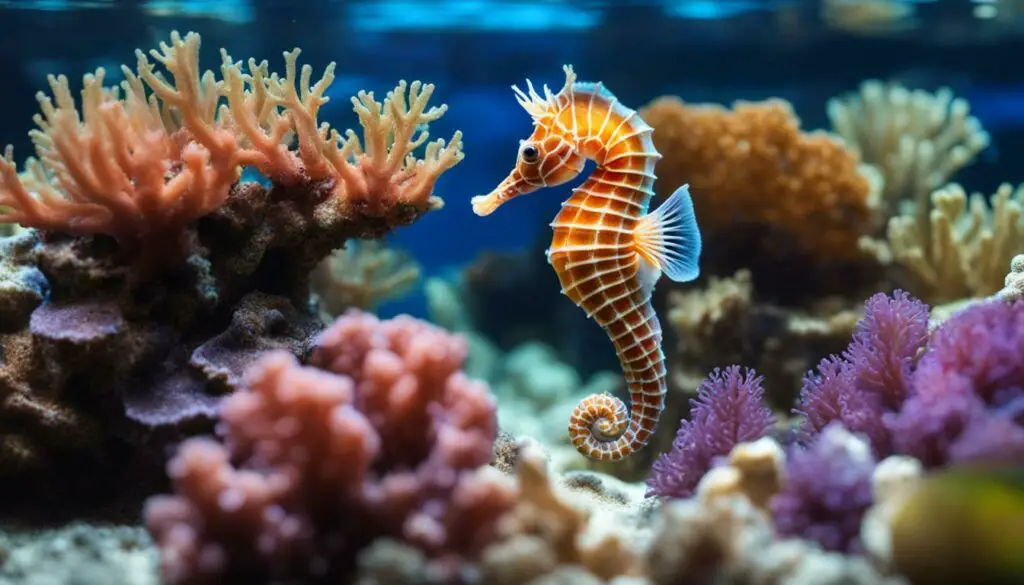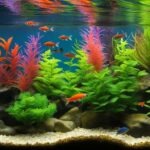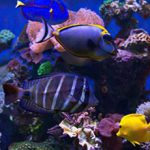Welcome to the world of pet seahorses! In this guide, I’ll share essential tips and insights on how to properly care for these unique and captivating marine animals. Caring for pet seahorses requires specialized systems and attention to detail. Seahorses belong in species tanks and require the right aquarium setup, appropriate tankmates, and specific types of food. They are unique creatures that swim in an upright position and have a long, prehensile tail. Seahorses naturally occur in shallow, calm waters with dense growths of seagrass or macroalgae.
Key Takeaways:
- Seahorses require specialized care and attention to thrive in captivity.
- Proper aquarium setup, including a quality sea salt mix and bio-active substrate, is essential for their well-being.
- Seahorses prefer live foods, such as copepods and brine shrimp, and frequent, small feedings are recommended.
- Owning a pet seahorse offers benefits like being hypoallergenic and providing a unique learning opportunity.
- However, caring for seahorses can be challenging due to their specific needs and frequent feedings.
Understanding Seahorses as Pets
Before diving into the specifics of caring for pet seahorses, let’s take a moment to understand what makes these fascinating creatures such delightful companions. Seahorses belong to the genus Hippocampus and are known for their unique appearance and gentle nature. These enchanting creatures have a prehensile tail, which they use to grip onto objects in their environment. They swim in an upright position, propelling themselves forward with the use of their dorsal fin.
Seahorses are found in shallow, calm waters with dense growths of seagrass or macroalgae. Their natural habitat plays a crucial role in understanding their care needs as pets. To replicate their natural environment in captivity, seahorses require specialized systems and attention to detail.
| Fact | Information |
|---|---|
| Scientific Name | Hippocampus spp. |
| Size | 2 to 14 inches |
| Life Span | 1 to 5 years |
| Tank Size | 30 gallons or larger |
| Water Temperature | 72-78°F |
| Water Salinity | 1.023-1.025 |
When setting up a seahorse aquarium, it is important to provide them with the right environment. A quality sea salt mix should be used to create the ideal salinity level, and the water temperature should be kept between 72-78°F. The tank should have a bio-active substrate and an oversized filter to maintain water quality, as seahorses are sensitive to water parameters. It is crucial to keep water flow minimal and minimize air bubbles in the tank to prevent stress on the seahorses.
Seahorses also need a “hitching post” to hold onto while at rest. Real or artificial plants and seaweeds provide a suitable place for them to anchor themselves. Adding these elements not only enhances the aesthetics of the tank but also creates a sense of security for the seahorses.
It is essential to research the specific needs of different seahorse species before bringing them home. Each species may have slightly different care requirements, and understanding these nuances is vital for their well-being. By providing the right environment and attending to their particular needs, you can ensure that your pet seahorse thrives in captivity for years to come.
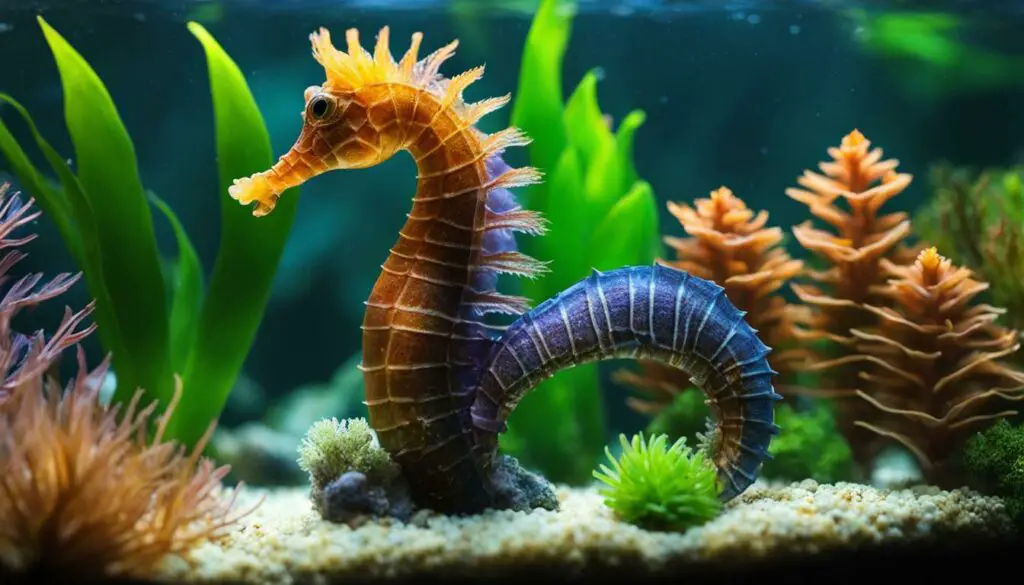
Setting Up the Perfect Seahorse Habitat
Creating a suitable habitat is crucial for the well-being of your pet seahorse. Let’s explore the essential elements needed to set up the perfect seahorse tank.
When it comes to seahorse tanks, there are a few key factors to consider. First and foremost, a quality sea salt mix is essential for maintaining proper water chemistry. This will provide the necessary minerals and trace elements for your seahorse’s health. Additionally, a bio-active substrate, such as live sand or crushed coral, can help maintain water stability and support beneficial bacteria that aid in filtration.
Water flow is another important consideration. Seahorses are not strong swimmers and prefer minimal water movement. Aim for a gentle flow by using a wide, low-flow filter and positioning it strategically in the tank. It’s also crucial to minimize air bubbles, as these can cause stress and discomfort for the seahorse.
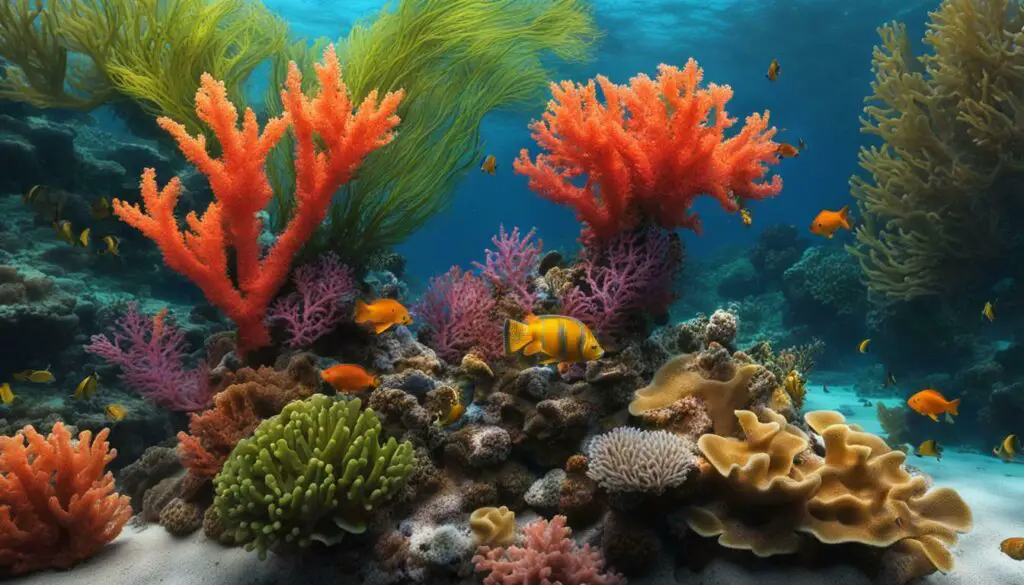
Seahorses are known for their unique ability to grasp onto objects with their prehensile tails. Providing them with a “hitching post” is essential for their well-being. You can use real or artificial plants and seaweeds in the tank for this purpose. These not only offer a place for seahorses to rest, but also contribute to a natural and aesthetically pleasing environment.
Finally, it’s important to research the specific needs of different seahorse species before bringing them home. Some species may require specific temperature ranges, lighting conditions, or tank sizes. By understanding the specific requirements of your chosen seahorse species, you can create a habitat that meets their individual needs.
Choosing the Right Seahorse Species for Beginners
With various seahorse species available, it’s important to select the right one that suits your level of experience and commitment. Different seahorse species have different care requirements, temperaments, and levels of difficulty to maintain. For beginners, it is advisable to choose hardy and resilient seahorse species that can adapt well to captive environments.
Hippocampus erectus, commonly known as the Lined Seahorse, is a popular choice for beginners. They are relatively easy to care for and can tolerate a wide range of water conditions. Another suitable option is the Hippocampus kuda, or the Spotted Seahorse, which is known for its vibrant colors and striking appearance. These seahorses are generally less demanding in terms of care and can thrive in a well-maintained aquarium.
If you are looking for a smaller seahorse species, consider the Hippocampus zosterae, also known as the Dwarf Seahorse. These tiny seahorses are relatively low-maintenance and can be kept in smaller tanks. They are a great choice for beginners who are new to seahorse keeping.
| Seahorse Species | Level of Difficulty | Care Requirements |
|---|---|---|
| Lined Seahorse | Easy | Tolerant of a wide range of conditions |
| Spotted Seahorse | Easy | Colorful and less demanding |
| Dwarf Seahorse | Beginner-friendly | Low-maintenance and suitable for smaller tanks |
Before making a decision, research each species thoroughly to understand their specific care needs, tank size requirements, and compatibility with other tankmates. It’s essential to create a suitable environment that mimics their natural habitat, with the right water parameters and appropriate tank setup.
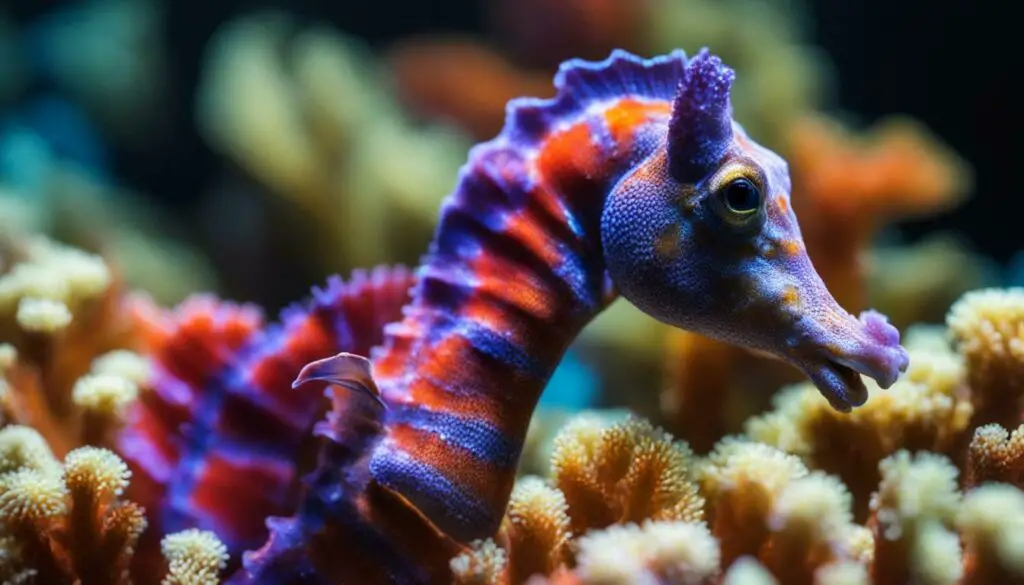
Maintaining Optimal Water Quality
Clean and stable water conditions are essential for the health and happiness of your pet seahorse. Here’s how to keep the water quality in check.
Firstly, it’s important to invest in a quality sea salt mix to ensure the right mineral balance in the tank. Follow the instructions carefully for the appropriate saltwater concentration. Additionally, a bio-active substrate can help maintain water quality by promoting beneficial bacteria growth. This bacteria helps break down waste and reduces the risk of harmful ammonia and nitrite levels.
An oversized filter is crucial for a seahorse tank. A filter with a slow flow rate is ideal as seahorses are not strong swimmers and may struggle with strong currents. Minimizing air bubbles and using a filter with adjustable settings can help create a gentle flow that won’t stress out your seahorse.
Seahorses require a “hitching post” in their tank – a structure they can hold onto while resting. Real or artificial plants and seaweeds make excellent hitching posts and provide a natural environment for your seahorse. It’s important to research the specific needs of your seahorse species to ensure you’re providing the right tank setup.
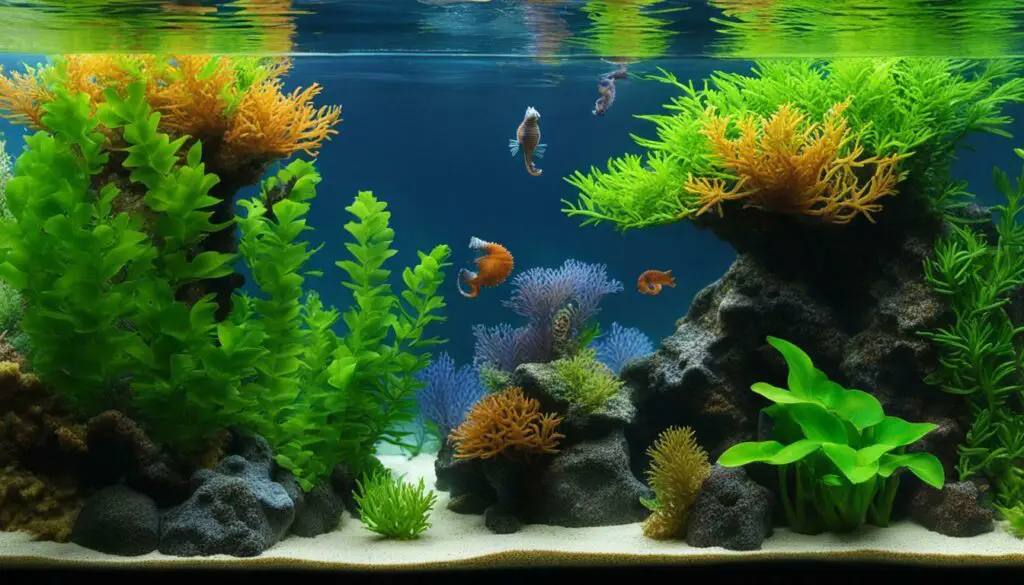
Table: Water Quality Parameters for Seahorse Tank
| Parameter | Ideal Range |
|---|---|
| Temperature | 72-78°F (22-26°C) |
| pH | 8.0-8.4 |
| Ammonia | 0 ppm |
| Nitrite | 0 ppm |
| Nitrate | |
| Salinity | 1.020-1.025 |
Regular monitoring of the water parameters is essential to ensure a healthy environment for your seahorse. Use reliable testing kits to check the temperature, pH, ammonia, nitrite, nitrate, and salinity levels. Maintain a consistent schedule for water changes to keep these parameters within the ideal range.
Remember, small changes are better for seahorses. Sudden fluctuations or drastic changes in water conditions can cause stress and harm to your seahorse. By providing a clean and stable habitat, you’ll be laying the foundation for a thriving and happy pet seahorse.
Creating a Suitable Seahorse Diet
Feeding your pet seahorse the right food is crucial for its overall well-being. Let’s explore the dietary needs of these captivating creatures.
Seahorses are unique creatures with specific dietary requirements. Their small mouths and lack of teeth make them ineffective hunters, so they rely on their snouts to suck up food like a vacuum. In the wild, seahorses mainly feed on live prey, including small crustaceans like copepods and brine shrimp. As a pet owner, it’s essential to replicate this natural diet in captivity.
“Seahorses are known to be finicky eaters, so it’s important to offer a variety of food options,” says Dr. Jane Wilson, a marine biologist with years of experience in seahorse care.
“I recommend providing a mix of live foods, such as copepods and adult brine shrimp, along with frozen mysis shrimp and enriched Artemia nauplii. A diverse diet helps ensure that your seahorse receives the necessary nutrients.”
It’s important to note that tank-bred seahorses are generally less finicky at mealtime compared to their wild-caught counterparts. They have been raised on a diet of frozen or dry foods, making the transition to captivity easier. However, regardless of their origin, seahorses should be fed small amounts several times a day to match their natural feeding patterns. You may need to temporarily turn off the filtration system during feeding time to prevent the food from being sucked into the filter.
| Recommended Foods | Feeding Frequency |
|---|---|
| Copepods | 2-3 times daily |
| Brine shrimp | Every other day |
| Frozen mysis shrimp | 2-3 times weekly |
| Enriched Artemia nauplii | Twice a week |
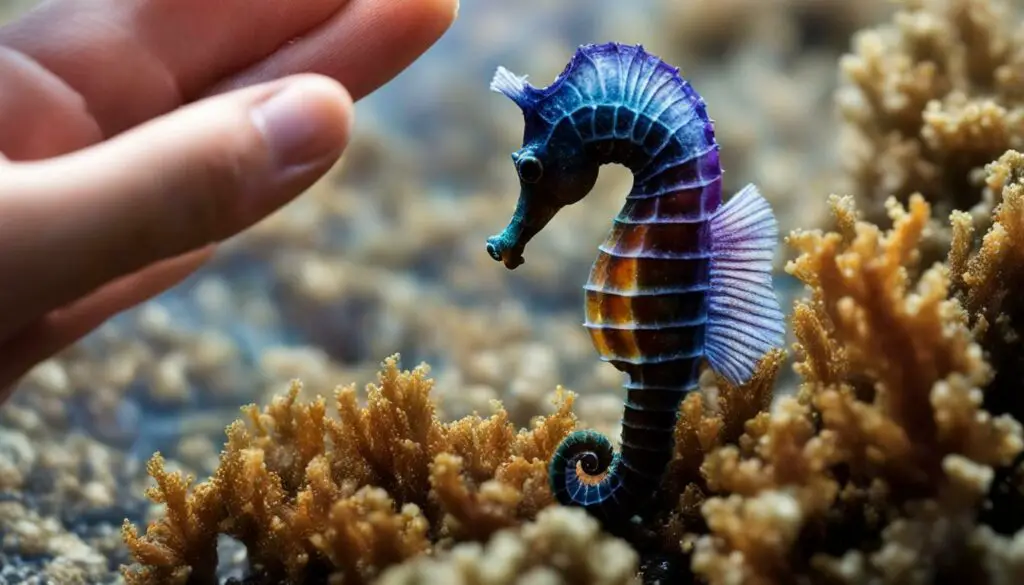
Owning a seahorse as a pet comes with its challenges, but providing them with a suitable diet is a fundamental aspect of their care. By offering a variety of live and frozen foods, you can ensure that your pet seahorse thrives in captivity for years to come.
Live Feeding for Happier Seahorses
Seahorses are known for their preference for live food, and providing them with a varied and nutritious diet is key to their health and happiness. These delicate creatures thrive on small, frequent feedings consisting of live prey such as copepods and brine shrimp. While it may require some extra effort, the rewards of watching your seahorses actively hunt and feed make it well worth it.
Feeding live food to seahorses can be a challenging task. However, with the right preparation and resources, you can ensure that your seahorses receive the nutrition they need. Cultivating a population of copepods in a refugium or purchasing them from a reputable source is an excellent way to provide a continuous supply of live food. Additionally, brine shrimp can be hatched at home or purchased as frozen or live specimens.
| Benefits of Live Feeding for Seahorses | Tips for Successful Live Feeding |
|---|---|
|
|
Remember, frequent, small feedings throughout the day are better than infrequent, large feedings. It’s important to observe your seahorses during feeding time and ensure that they are actively consuming the food. If necessary, temporarily turning off the filtration system can help prevent the food from being swept away before the seahorses can consume it. A well-planned and consistent live feeding routine is essential for the well-being of your beloved seahorses.
Providing live food for your seahorses not only satisfies their natural instincts but also offers you the opportunity to observe their fascinating feeding behavior up close. The excitement of watching them hunt and devour their prey is truly a rewarding experience for any seahorse enthusiast.
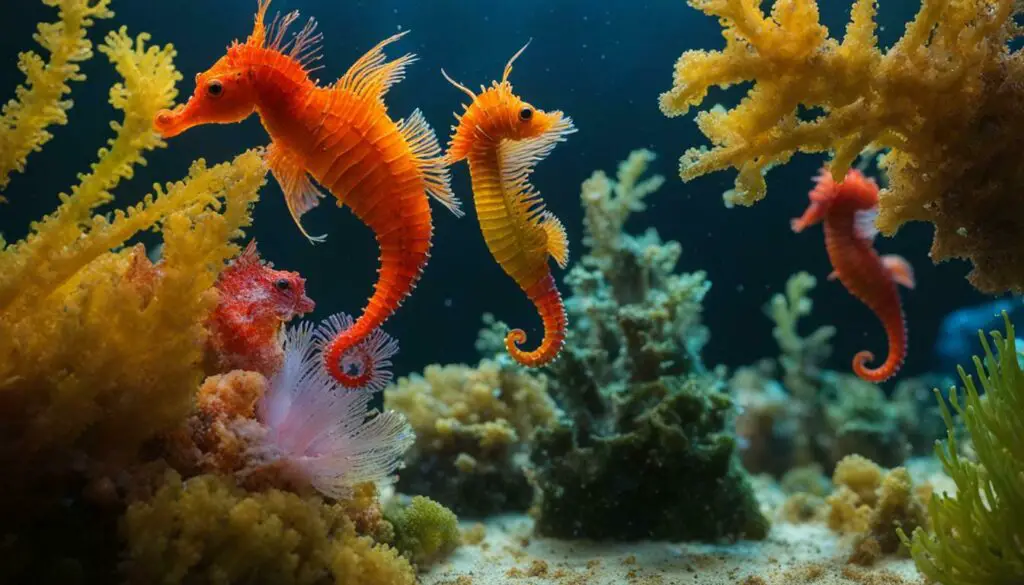
Conclusion:
Feeding live food to your pet seahorses is crucial for their overall health and well-being. By incorporating a variety of live prey, monitoring feeding amounts, and establishing a separate feeding tank, you can ensure that your seahorses receive a balanced and nutritious diet. While live feeding may require extra effort, the reward of witnessing your seahorses actively feeding and thriving makes it all worthwhile.
Tankmates and Compatibility
While it’s tempting to add other marine creatures to the seahorse tank, careful consideration is necessary to ensure the well-being of your delicate companions. Seahorses are slow and gentle creatures, and they require a calm and peaceful environment to thrive. Introducing aggressive or fast-swimming tankmates can cause stress and potentially harm the seahorses. It’s essential to choose compatible tankmates that won’t compete for food or harass the seahorses.
When selecting tankmates for seahorses, it’s crucial to choose species that have similar care requirements and temperaments. Some suitable tankmates for seahorses include smaller fish like gobies, pipefish, and certain species of blennies. These fish are generally mellow and won’t pose a threat to the seahorses. However, it’s important to research each species thoroughly to ensure compatibility.
It’s also worth considering invertebrates as tankmates for seahorses. Snails, hermit crabs, and shrimp can make interesting additions to the tank and help with maintaining the ecosystem. However, be cautious when selecting shrimp species, as some may nip at the seahorses or compete for food.
Table 1: Recommended Seahorse Tankmates
| Species | Characteristics |
|---|---|
| Gobies | Small, peaceful fish that won’t harm seahorses |
| Pipefish | Similar appearance to seahorses, peaceful temperament |
| Blennies | Generally non-aggressive, suitable for larger tanks |
| Snails | Help with algae control, won’t harm seahorses |
| Hermit crabs | Interesting scavengers, won’t pose a threat |
Remember that even with compatible tankmates, careful monitoring is necessary to ensure everyone is getting along well. Keep an eye on the interactions between the seahorses and other inhabitants of the tank. If any aggression or stress is observed, it may be necessary to separate the individuals for their safety.
The seahorse tank should be spacious enough to accommodate all the inhabitants comfortably. Providing plenty of hiding spots, such as caves or crevices, will help reduce stress and provide the seahorses with a sense of security. It’s also important to maintain stable water conditions by conducting regular water tests and performing necessary water changes. With proper research, planning, and compatibility considerations, you can create a harmonious and thriving aquarium for your pet seahorses.
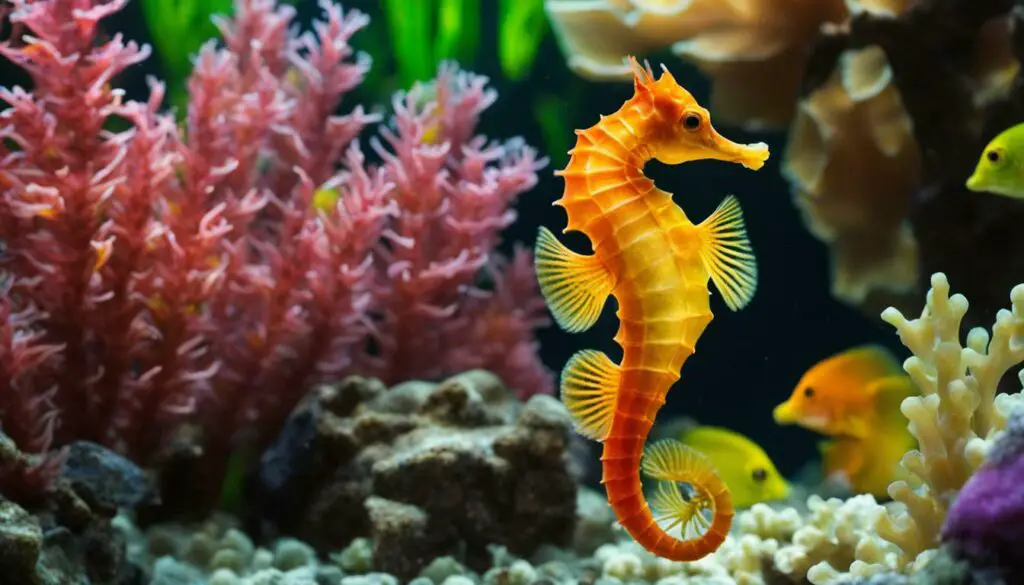
Understanding Seahorse Behavior
Seahorses have fascinating behaviors that set them apart from other pets. Let’s delve into their behavior patterns and learn how to best respond to their needs.
One interesting behavior of seahorses is their ability to change color. They have specialized cells called chromatophores in their skin that allow them to blend in with their surroundings. This natural camouflage helps them hide from predators and also serves as a way to communicate with other seahorses. For example, when a seahorse is angry or stressed, it may become darker in color. Understanding these color changes can help us gauge the mood and well-being of our pet seahorse.
Seahorses are also known for their unique courtship rituals. During courtship, the male seahorse performs an elaborate dance to attract a female. The dance involves intricate movements, including bobbing up and down and twirling around each other. It is a truly mesmerizing sight to behold. Once the male and female form a bond, they engage in a mating ritual where the female deposits her eggs into a specialized pouch on the male’s abdomen. The male then fertilizes the eggs and carries them until they hatch. This paternal care is a remarkable behavior that is rare in the animal kingdom.
Seahorse Behavior at Rest
When seahorses are at rest, they exhibit a unique behavior known as “hitching.” Seahorses have a prehensile tail that they use to grasp onto objects, such as seagrass or coral. Providing a suitable “hitching post” in the aquarium is essential for their well-being. This can be a real or artificial plant or seaweed that they can hold onto to stay stable. The hitching post should be sturdy and positioned near the water surface to allow easy access for the seahorse. It’s important to observe and ensure that your seahorse has a secure grip while resting to prevent any accidents.
To better understand and respond to seahorse behavior, it’s crucial to spend time observing them. Take note of their color changes, courtship dances, and resting habits. By closely observing and understanding their behaviors, we can provide the best care and enrich their lives in captivity.
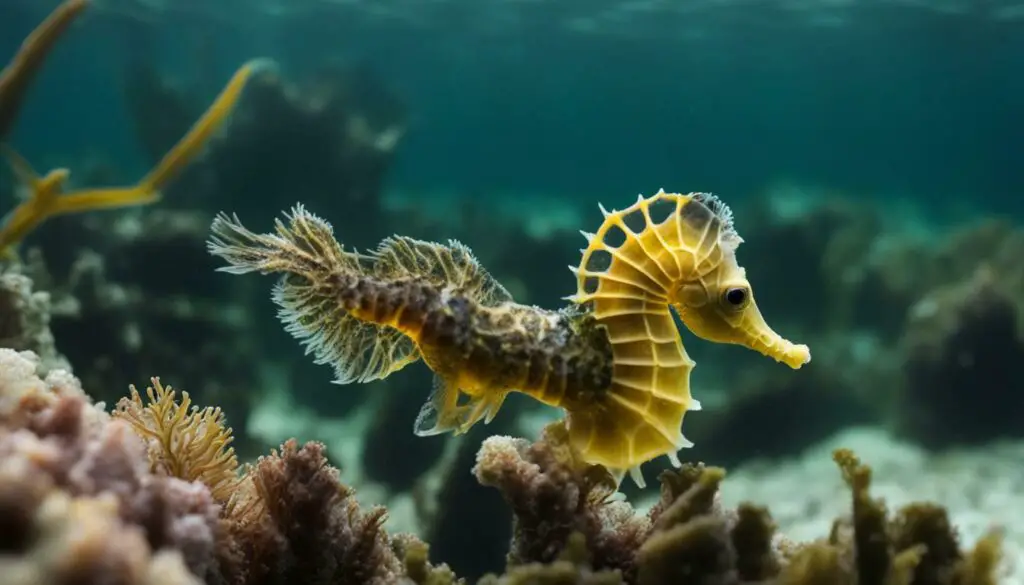
| Behavior | Description |
|---|---|
| Color change | Seahorses can change their color to blend in with their surroundings or communicate their mood. |
| Courtship dance | Male seahorses perform an elaborate dance to attract a female. |
| Hitching | Seahorses use their prehensile tail to hold onto objects and stay stable while at rest. |
Seahorse Reproduction: A Delicate Process
Seahorse reproduction is a truly remarkable and delicate process. Let’s explore the intricacies of seahorse breeding and learn how to support their reproductive needs.
Unlike most fish, seahorses possess a unique form of reproduction where the male carries and gives birth to the babies. This makes seahorses a fascinating species to observe and care for. However, successful seahorse breeding requires careful attention to detail and the right setup in the aquarium.
To create a conducive environment for seahorse reproduction, it’s crucial to provide a suitable habitat with plenty of hiding spots and a well-maintained water quality. Male seahorses are equipped with a brood pouch where they carry fertilized eggs until they are ready to be released. During this period, it’s essential to minimize disturbances and maintain stable water conditions to ensure the health and development of the embryos.
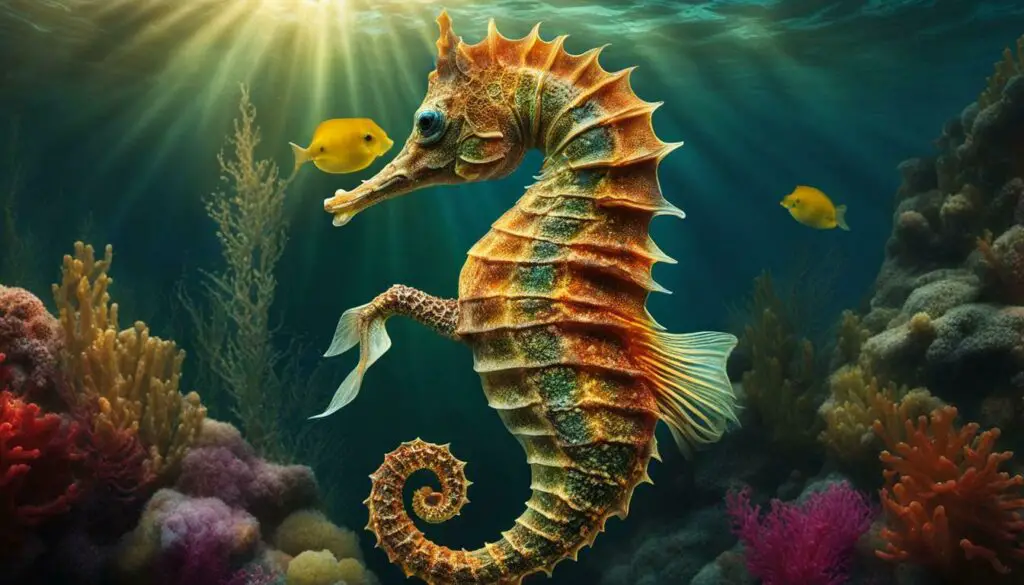
When it’s time for the male seahorse to give birth, it’s an exciting and critical moment. The babies, known as fry, are released into the water, and their survival greatly depends on their ability to find food and avoid predators. Providing live food options such as copepods or brine shrimp is essential to support the fry’s growth and development. It’s important to note that seahorse fry are delicate and require specific care to ensure their survival.
Supporting seahorse reproduction requires patience, knowledge, and a deep understanding of their unique biology. By creating an ideal environment and catering to their specific needs, you can witness the incredible journey of seahorse breeding and contribute to the conservation of these beautiful creatures.
The Benefits of Owning a Seahorse
Owning a pet seahorse comes with a myriad of benefits, from their hypoallergenic qualities to the valuable lessons they teach us about marine life. These enchanting creatures have captured the hearts of many with their unique appearance and captivating behaviors. As a pet, seahorses offer an extraordinary experience that can be both rewarding and educational.
One of the remarkable benefits of owning a seahorse is their hypoallergenic nature. Unlike many other pets, seahorses do not produce dander or shed fur, making them an ideal choice for individuals with allergies. This makes it possible for more people to enjoy the companionship of an extraordinary marine creature without worrying about allergens that can cause discomfort.
Furthermore, seahorses provide an unparalleled opportunity to learn about the intricate world of marine life. By observing their behavior and understanding their specific care requirements, owners gain a deeper appreciation for the delicate balance of aquatic ecosystems. It’s a chance to witness firsthand the marvels of nature and cultivate a sense of responsibility towards preserving our oceans.
| Hypoallergenic Qualities | Learning Opportunities |
|---|---|
|
|
“Seahorses, with their delicate beauty and unique behavior, provide an extraordinary opportunity for individuals seeking a pet that goes beyond the ordinary.”
However, it is important to note that owning a seahorse also comes with its challenges. These delicate creatures require specialized care and attention to detail. Their tank setup needs to replicate their natural habitat, with the right water quality, appropriate tankmates, and specific types of food. Seahorses are not strong swimmers, so it is crucial to choose tankmates carefully to avoid any harm to these gentle creatures.
In conclusion, owning a seahorse as a pet is a one-of-a-kind experience that brings joy and wonder into our lives. From their hypoallergenic qualities to the invaluable lessons they teach us, seahorses have become beloved companions for those seeking a deeper connection with the marine world. With the proper care and dedication, a seahorse can thrive in captivity, providing a lasting source of fascination and admiration.
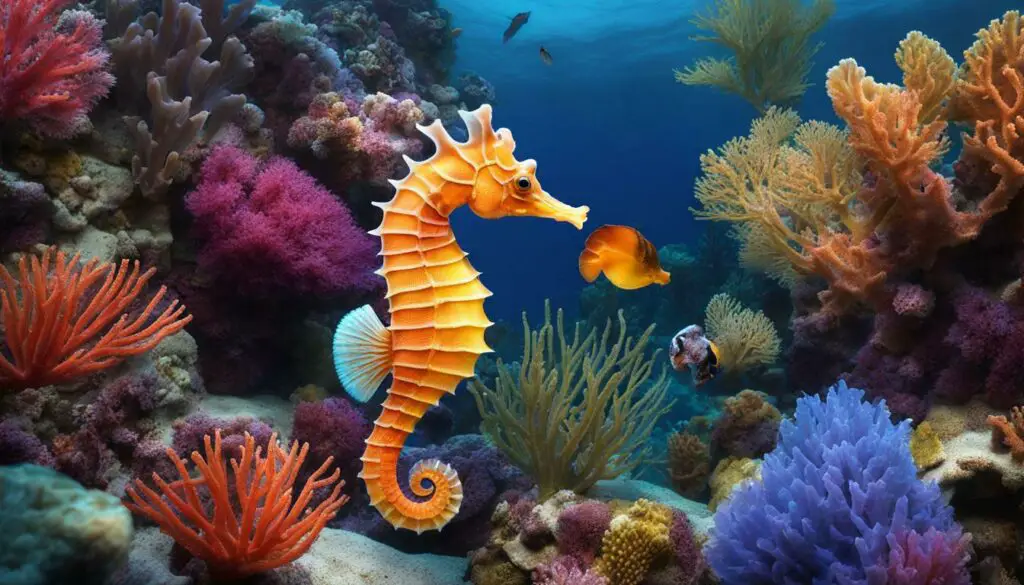
The Challenges of Pet Seahorse Care
While owning a pet seahorse can be immensely rewarding, it’s essential to be aware of the challenges involved to provide the best care for these unique creatures. Caring for pet seahorses requires specialized systems and attention to detail. Seahorses belong in species tanks and require the right aquarium setup, appropriate tankmates, and specific types of food. They are unique creatures that swim in an upright position and have a long, prehensile tail. Seahorses naturally occur in shallow, calm waters with dense growths of seagrass or macroalgae.
The seahorse aquarium should have a quality sea salt mix, a bio-active substrate, and an oversized filter to maintain water quality. Water flow should be minimal, and air bubbles should be minimized. Seahorses need a “hitching post” to hold onto while at rest, and they like real or artificial plants/seaweeds. It is important to research the specific needs of different seahorse species before bringing them home.
Feeding seahorses can be challenging as they prefer live foods, such as copepods and brine shrimp. Tank-bred seahorses are less finicky at mealtime compared to wild-caught ones. Frequent, small feedings throughout the day are better than infrequent, large feedings. Feeding time may require turning off the filtration system temporarily.
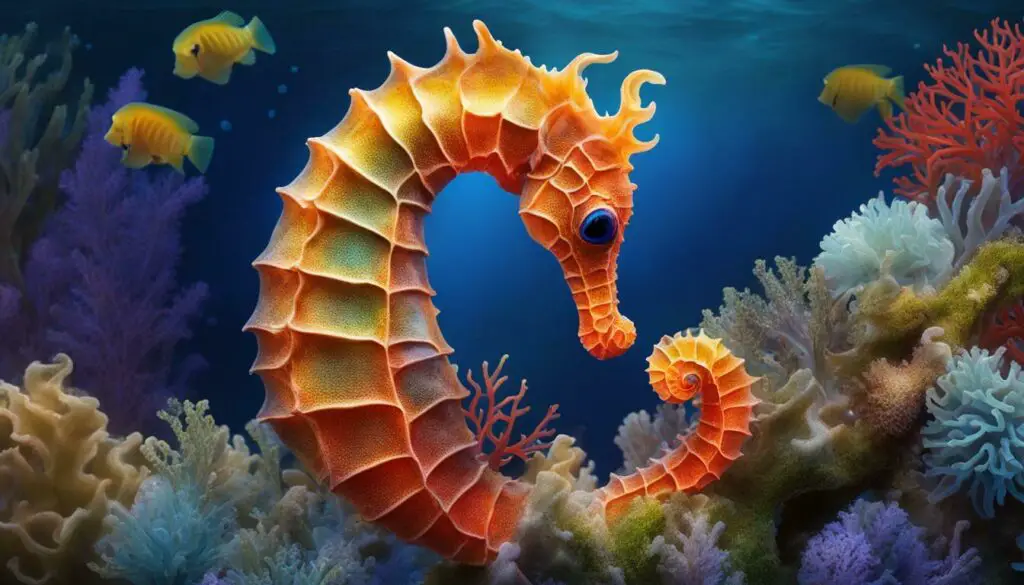
Owning a seahorse as a pet has several benefits, including being hypoallergenic and offering a unique learning opportunity. However, there are downsides to consider, such as the need for specialized care, frequent feedings, and heavy filtration. Seahorses are not strong swimmers, so tankmates should be carefully chosen. Overall, with the proper care, a seahorse can thrive in captivity for years.
A Long and Thriving Life for Your Seahorse
With the right care and attention, your pet seahorse can enjoy a fulfilling and healthy life by your side for years to come. Caring for pet seahorses requires specialized systems and attention to detail. Seahorses belong in species tanks and require the right aquarium setup, appropriate tankmates, and specific types of food.
| Fact | Description |
|---|---|
| Physical Characteristics | Seahorses are unique creatures that swim in an upright position and have a long, prehensile tail. They come in various colors and patterns, adding beauty to any aquarium. |
| Habitat | Seahorses naturally occur in shallow, calm waters with dense growths of seagrass or macroalgae. Replicating this environment in their tank is crucial for their well-being. |
| Aquarium Setup | The seahorse aquarium should have a quality sea salt mix, a bio-active substrate, and an oversized filter to maintain water quality. Water flow should be minimal, and air bubbles should be minimized. Seahorses need a “hitching post” to hold onto while at rest, and they enjoy real or artificial plants/seaweeds. |
| Feeding | Feeding seahorses can be challenging as they prefer live foods, such as copepods and brine shrimp. Tank-bred seahorses are less finicky at mealtime compared to wild-caught ones. Frequent, small feedings throughout the day are better than infrequent, large feedings. Feeding time may require turning off the filtration system temporarily. |
“With the proper care, a seahorse can thrive in captivity for years.”
Owning a seahorse as a pet has several benefits, including being hypoallergenic and offering a unique learning opportunity. However, there are downsides to consider, such as the need for specialized care, frequent feedings, and heavy filtration. Seahorses are not strong swimmers, so tankmates should be carefully chosen. Proper research on the specific needs of different seahorse species is essential before bringing them home.
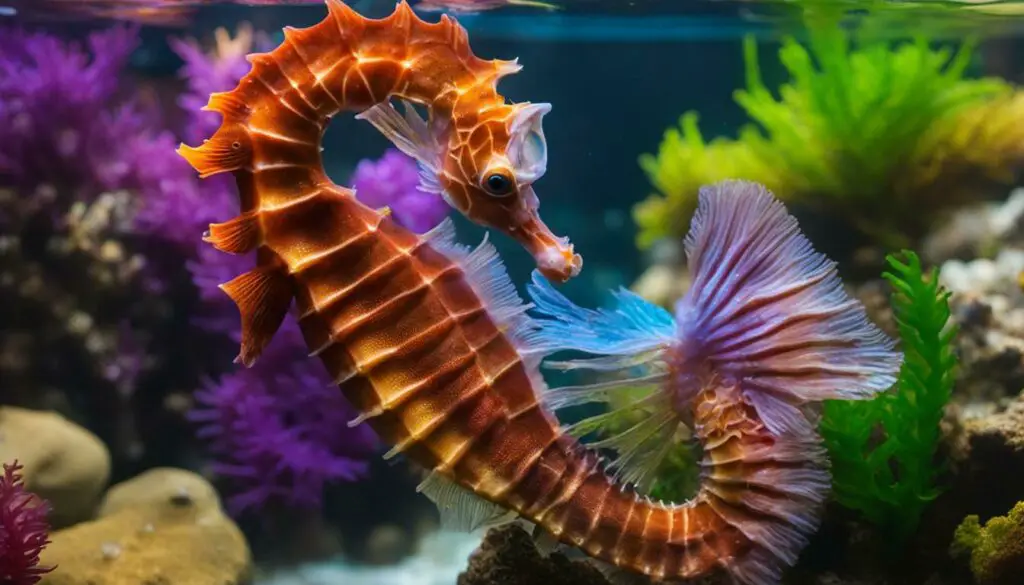
Remember, the key to a healthy seahorse is providing a suitable habitat, maintaining optimal water quality, and offering a nutritious diet. With patience, dedication, and a deep understanding of their unique needs, you can provide your pet seahorse with a long and thriving life.
Where to Find Pet Seahorses
If you’re ready to embark on your seahorse-keeping journey, here are some resources and tips to help you find the perfect pet seahorse. One option is to visit reputable aquarium stores in your area. These stores often have a variety of seahorse species available for purchase. Make sure to inquire about the source of the seahorses and ask for information on their care requirements.
Another option is to connect with seahorse breeders or hobbyists. Online forums and social media groups dedicated to seahorse enthusiasts are great places to network and find reputable breeders who have healthy and well-cared-for seahorses for sale. These breeders can provide valuable advice on caring for your new pet and may even be able to offer ongoing support.
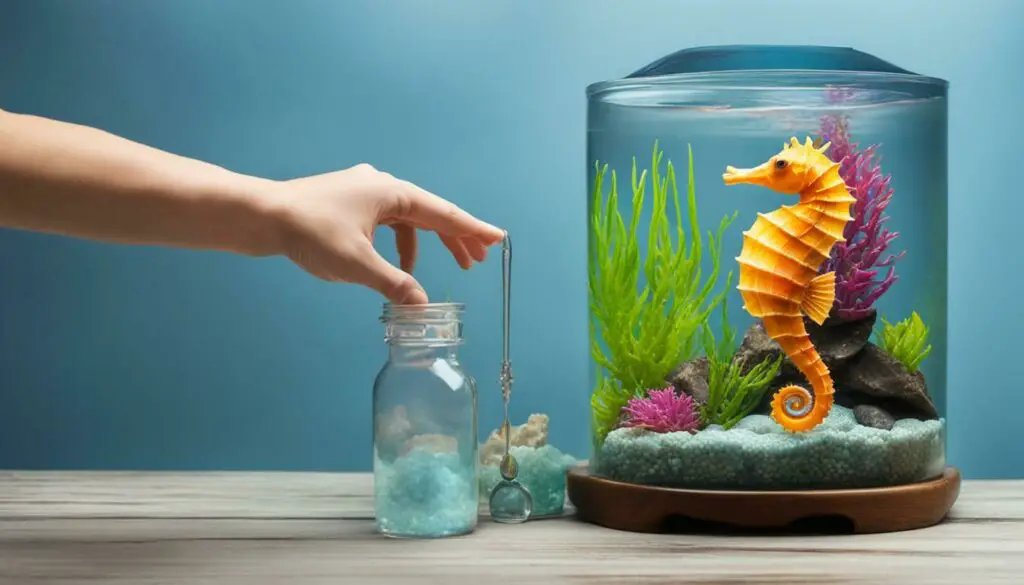
When purchasing a pet seahorse, it’s important to ensure that it has been tank-bred rather than wild-caught. Tank-bred seahorses tend to be hardier and more adaptable to aquarium life compared to those taken from the wild. They also help support conservation efforts by reducing the demand for wild-caught specimens.
Remember that seahorses require specialized care, so it’s crucial to do your research and choose a reputable source. Look for breeders or stores that prioritize the health and well-being of their seahorses. Ask questions about their breeding practices, the environment in which the seahorses are raised, and the diet they are fed. A knowledgeable and reputable source will be transparent and provide all the information you need to ensure a successful and fulfilling seahorse-keeping experience.
| Pros | Cons |
|---|---|
| – Hypoallergenic pets | – Specialized care requirements |
| – Unique learning opportunities | – Frequent feedings |
| – Captivating and beautiful creatures | – Heavy filtration needs |
Conclusion
Caring for a pet seahorse may require specialized knowledge and effort, but the rewards of witnessing their beauty and uniqueness up close makes it all worthwhile. Seahorses are fascinating creatures that swim in an upright position and have a long, prehensile tail. They thrive in species-specific tanks with the right aquarium setup, appropriate tankmates, and specific types of food.
Creating the ideal seahorse habitat involves using a quality sea salt mix, a bio-active substrate, and an oversized filter to maintain water quality. It is important to minimize water flow and air bubbles to ensure the comfort of these delicate creatures. Seahorses also need a “hitching post” to hold onto while at rest, and they enjoy the presence of real or artificial plants and seaweeds.
Feeding seahorses can be a challenging task as they prefer live foods, such as copepods and brine shrimp. Tank-bred seahorses tend to be less finicky at mealtime compared to wild-caught ones. Frequent, small feedings throughout the day are better than infrequent, large feedings. Feeding time may require temporarily turning off the filtration system to allow the seahorses to consume their food easily.
Although owning a pet seahorse brings several benefits, such as being hypoallergenic and offering a unique learning opportunity, it is important to consider the downsides. Providing specialized care, frequent feedings, and heavy filtration are necessary to ensure the well-being of these delicate creatures. Additionally, tankmates should be chosen carefully, as seahorses are not strong swimmers.
With the proper care and attention, a seahorse can thrive in captivity for years, bringing joy and wonder to its owner. By understanding their specific needs and dedicating the time and effort required, anyone can enjoy the fascinating experience of having a pet seahorse.
FAQ
What kind of tank setup do seahorses need?
Seahorses require a specialized aquarium setup with minimal water flow, an oversized filter, and a “hitching post” for them to hold onto while at rest. Real or artificial plants/seaweeds are also recommended.
What do seahorses eat?
Seahorses prefer live foods such as copepods and brine shrimp. Tank-bred seahorses are less finicky at mealtime compared to wild-caught ones. Frequent, small feedings throughout the day are better than infrequent, large feedings.
Can seahorses live with other fish?
Tankmates for seahorses should be carefully chosen as seahorses are not strong swimmers. It is important to research compatible species and consider the needs of both seahorses and other fish before introducing them to the same tank.
How long do seahorses live?
With proper care, seahorses can thrive in captivity for several years. Their lifespan can vary depending on the species and individual health.
Is owning a seahorse a lot of work?
Caring for seahorses requires specialized care and attention to detail. They have specific tank requirements, feeding needs, and filtration considerations. While they can be rewarding pets, they do require a commitment to their care.
Are seahorses hypoallergenic?
Yes, seahorses are hypoallergenic, making them a suitable option for individuals with allergies to other pets.

